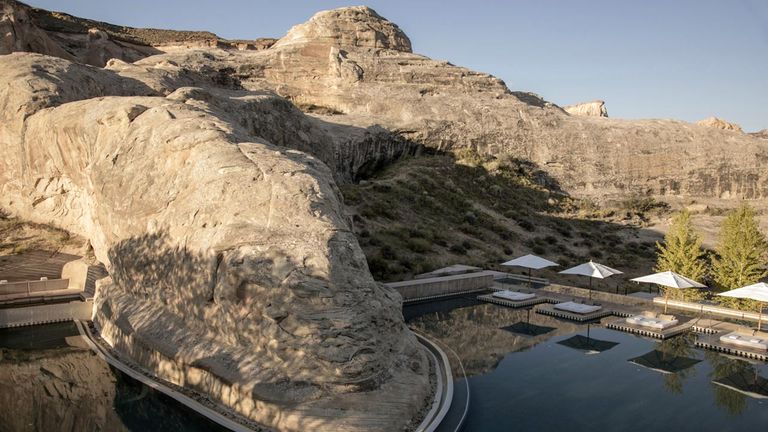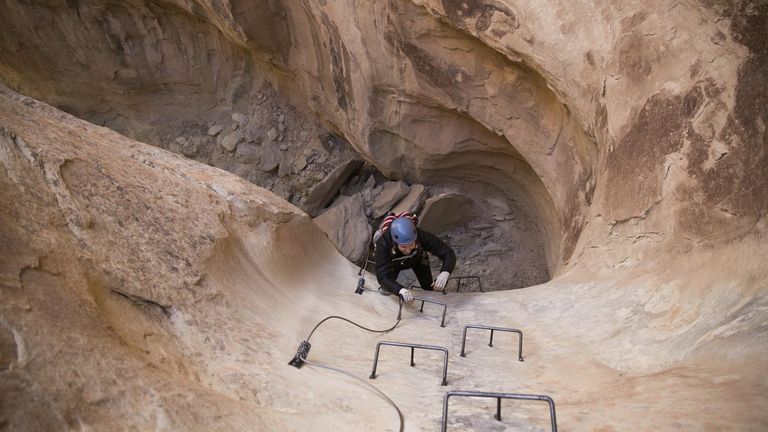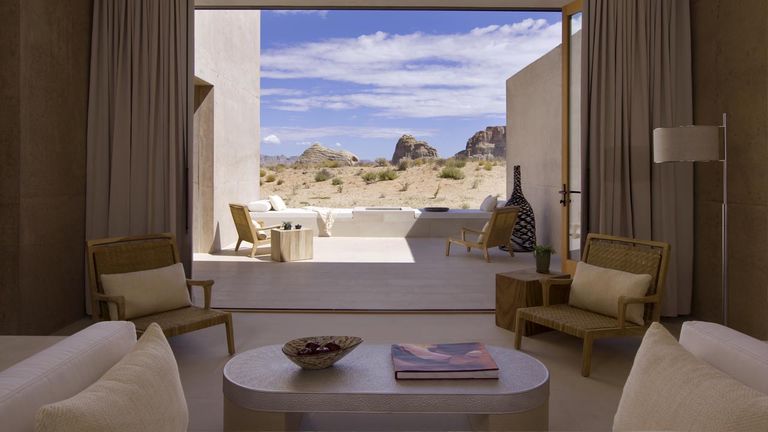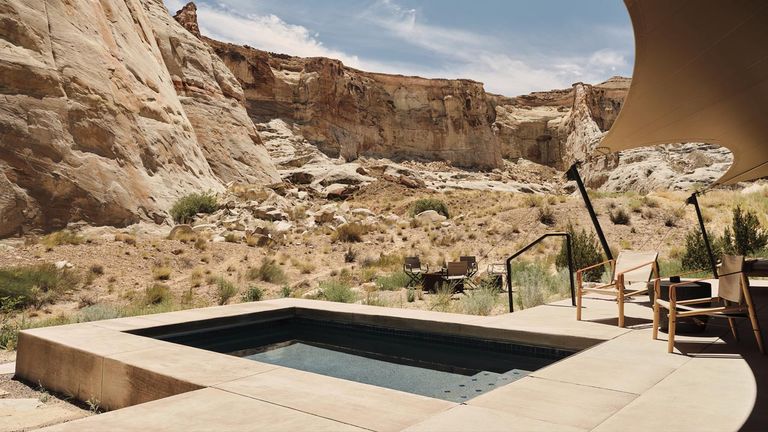If there existed a perfect time to immerse oneself in nature, it is now. And there is perhaps no better place to be one with the sun, sky and stars than Amangiri, an ultra-luxury resort in Canyon Point, Utah, between Kanab and Page, Ariz.
But don’t take my word for it. According to Julien Surget, general manager of the resort, the property has been booked solid ever since it reopened in May. And though it’s operating at reduced capacity due to COVID-19, the introduction of Camp Sarika and its 10 new tented pavilions — and a guest desire to focus on self-care — has allowed the resort to be more profitable year-over-year.
During a time when folks are finding solace primarily in nature, Amangiri delivers. Here, the details do not just complement the surrounding landscape — they are built around them.
 Amangiri’s resort pool features a sandstone escarpment that is reminiscent of Horseshoe Bend.
Amangiri’s resort pool features a sandstone escarpment that is reminiscent of Horseshoe Bend.
Credit: 2020 Amangiri
Perhaps the best example of this is the property’s pool, where the borders arch around Studhorse Mesa, a 160-million-year-old sandstone escarpment that stretches on either side, far past the confines of the guest area and into the resort’s 600 acres. The protruding rock — and the water that flows around it — is uncannily reminiscent of nearby Horseshoe Bend, a narrow offshoot of the Colorado River that winds around a sandstone escarpment in the shape of a horseshoe.
When Amangiri Opened
According to Surget, Adrian Zecha, the founder of parent company Aman Resorts, was not happy with the land originally proposed for Amangiri. As the story goes, Zecha told the property owner that if he could get the government-owned land with its projecting sandstone boulder, then he would be involved. What ensued was a years-long process of swapping land with U.S. Bureau of Land Management — which even required approval from Congress.
Perhaps the best example of this is the property’s pool, where the borders arch around Studhorse Mesa, a 160-million-year-old sandstone escarpment that stretches on either side, far past the confines of the guest area and into the resort’s 600 acres.
Zecha’s vision was realized. Amangiri, which means “peaceful mountain,” opened in 2009, and the resort has become increasingly iconic.
Where is Amangiri Located?
Surget, who joined the property about four years ago, credits the spike in popularity with the incredible success of the 2016 National Park Service Centennial, which drew major attention to parks in the Colorado Plateau that are located within a few hours’ reach of the resort, including the Grand Canyon in Arizona and Zion and Bryce Canyon national parks in Utah. About 20 minutes away is Page, Ariz., which has become a gateway for these parks as well as Monument Valley, a butte-dotted landscape featured prominently in Western and modern films.
The resort is at the border of the Grand Staircase-Escalante National Monument, and minutes away from American Southwest road trip staples Horseshoe Bend, Lake Powell and Antelope Canyon (a slot canyon that wows visitors with its narrow passageways sandwiched by towering sandstone that has been eroded by wind and water into smooth, wave-like patterns).
Why Is Amangiri So Expensive?
As this swath of hoodoo- and mesa-studded land rose in prominence, so did the resort — which, to many, is unarguably the most exclusive (and expensive) in the U.S.
Besides for several high-end dude ranches, it is hard to think of another U.S. luxury resort that enjoys so much private access to nature, along with great cuisine, service and architecture. It’s even harder to think of one that enjoys such a unique landscape — and reserves it only for guests.
On my recent visit, while on a sunset hike on one of the resort’s trails for a meditation and sound bath, our instructor, Missy, pointed out the beginnings of a slot canyon that was forming right under our feet.
Throughout the acreage, there are countless geologic and natural wonders, and it’s all there just for guests to explore — whether by lounging at the 25,000-square-foot spa or scaling one of four via ferratas installed in the surrounding sandstone. (Note: According to Mark, a guide with Adventure Partners — the operator that created and runs Amangiri’s adventure program — soft sandstone is not ideal for climbers, but it is perfect for via ferratas.)
 Use of the property’s via ferratas is exclusive to Amangiri guests.
Use of the property’s via ferratas is exclusive to Amangiri guests.
Credit: 2020 AmangiriEven gentle hikes require some scrambling, though the property makes this as painless as possible with discreet ropes, bridges and stairs that provide easy access to what’s around the corner. (Hint: Expect another gorgeous rock slab against a blue sky and pastel-colored desert plants such as Mormon tea, scrub oak, cliffrose and narrow leaf yucca.)
One of two complimentary hikes offered daily is the trek to Broken Arrow Cave (the site of the 1996 “Broken Arrow” film), a striking monolith featuring an ancient cave at its center.
At the archeological site, remains from up to 8,000 years ago have been found, and guests can inspect animal and vegetal relics, sharpened rocks that were chiseled into weapons and even a petroglyph representing a man.
 Amangiri’s architecture blends seamlessly with its unique landscape.
Amangiri’s architecture blends seamlessly with its unique landscape.
Credit: 2020 AmangiriChristian, another guide with Adventure Partners, took us into the cave — which can only be entered with a guide due to conservation efforts. From our shaded nook, it was easy to understand why the south-facing cave was a significant location for hunter-gatherers looking for shelter and healthy access to food and water.
So, How Much Is Amangiri Per Night?
The cave’s popularity with nomads foreshadowed the resort’s success — not so much with vagabonds, but with the elite jet set: professionals, models and celebrities, who are among the few who can afford the property’s entry fee. (This summer, Justin and Hayley Bieber and Kylie Jenner missed running into each other at Amangiri by just days.)
A weekend stay this September currently starts at $4,000 per night for a 1,000-square-foot Desert View Suite and includes three meals per day for two guests (alcohol, spa treatments and most excursions are extra).
This summer, Justin and Hayley Bieber and Kylie Jenner missed running into each other at Amangiri by just days.
Models and celebs seem the most taken by the resort’s brutalist architecture and high-contrast lighting, but even guests set on doing little other than snapping selfies will find themselves pleasantly immersed.
 Guestrooms feature neutral colors and face the desert landscape.
Guestrooms feature neutral colors and face the desert landscape.
Credit: 2020 AmangiriFor one, the guestroom palette takes a cue from the outdoors, with distressed concrete walls; lots of wood; beige and white furniture; and tiled showers and bathrooms the color of the sagebrush outside. Everything in the room — from the built-in bed and sofa to the shower and bath — faces a floor-to-ceiling view of the desert landscape, which features wildflowers and shrubs in the foreground and sandy hills and eroded mesas in the background.
The rooms echo the modernist architecture found throughout the property, where geometric shapes create slot-canyon-like openings that reveal even more dramatic surroundings.
Camp Sarika, a Resort Within a Resort at Amangiri
Those looking for more bragging rights — and an even deeper immersion into nature — can opt for the 10 standalone units at Camp Sarika, which launched July 2020 and includes its own restaurant and spa. The unexacting might erroneously call this “Amangiri glamping” — but the units are individually constructed bungalows, made of walls and insulation, wrapped in canvas.
Amangiri calls them “private canvas-ceilinged pavilions,” and the two-bedroom units are especially spacious and well-suited for families. Buying out the entire camp for small groups has become a popular, though not inexpensive option: A weekend stay in January (the slow season) at Camp Sarika starts at $4,800 for a 1,990-square-foot One Bedroom Pavilion and includes three meals per day for two guests.
 Each Camp Sarika pavilion features a private plunge pool.
Each Camp Sarika pavilion features a private plunge pool.
Credit: 2020 AmangiriDuring a tour of the camp, general manager Surget pointed out how designers Luxury Frontiers took great pains to place each pavilion where it would enjoy complete privacy, which is ideal as each has its own private terrace complete with an outdoor shower, a fire pit, a plunge pool and a telescope. Like with the main resort, the camp blends seamlessly into its surroundings and is hard to spot unless one squints in the right direction, from the right elevation.
With all the seclusion offered at Amangiri, the resort, and especially Camp Sarika, have become best-case examples of what guests want from their domestic travels during a pandemic.
But even now — as many of us slowly climb out of our hibernation pods and re-learn how to socialize — service remains the standout here. During my stay, staff throughout the property eased the newly socially awkward into a physically safe but not distant form of interaction.
And it’s clear that management has figured out a way to test aptitude for the skill of wanting to make client dreams come true. Again and again, employees went above and beyond to make every experience — from dining to taking a dip in the spa pool — one to remember.
When finding out it was our last night, Evan, our server at the main restaurant, insisted on sending s’mores to our room. (This was after he had surprised us with three desserts that night.) It was a sweet gesture — and not just because of the sugar.
No matter how beautiful Amangiri is during the day, it barely holds a candle to how the property transforms at night. With zero light pollution, the resort ensures that the night sky can fully reveal itself.
While the marshmallows toasted over the patio fireplace, the twinkling night sky jockeyed for my attention: Suddenly, a star launched itself diagonally overhead — followed by another.
It was never about the s’mores. Or the pool. At Amangiri, luxury is merely a means to connect guests to nature’s all-stars in novel and meaningful ways.
The Details
Amangiri